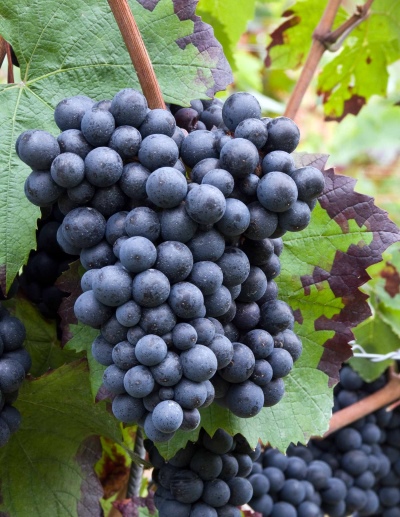
- Authors: Hungary
- Appointment: technical
- Berry color: black, with a thick bluish waxy coating
- Ripening period: average
- Frost resistance, ° C: -22
- Name synonyms: Bakator Sölö, Black Kadarka, Blaue Ungarishe, Blauer Kadarka, Gimza, Giemsa, Kadarka bleu, Kadarka kek, Kadarka nyagra, Kadarka modra, Kadarka fekete, Kadarka black, Mekish, Skadarka, Török Sölö, Black gizha, Chetereshka
- Yield: 8-12 t / ha
- Flower type: bisexual
- Density of the bunch: medium
- Skin: thin, medium strength
The technical variety Kadarka is well known to all professional winemakers and amateur gardeners. It has been successfully cultivated in Eastern Europe for decades, grown in Australia and Latin America. Also grapes Kadarka are known under the names Chetereshka, Bakator-Sölö, Black Kadarka, Chernaya Gizha, Blaue Ungarishe, Gumza or Gimza, Török Selö and others.
Breeding history
The variety is considered to come from Asia Minor, according to other versions, from Albania. Today it is ranked among the Hungarian group, the main selection work is carried out here. He has several clones at once, the most famous are Fol Kadarka, Kadarka Mal.
Description
The medium-sized Kadarka grape bush is covered with medium-sized leaves with a characteristic pubescence on the back. The shape of the plate is weakly dissected, usually with 3-5 lobes. The variety is good and actively gives growth of shoots, young vines are slightly pubescent, ribbed, straight, olive or green. The internodes are short, the buds are red, covered with hairs.
Ripening period
For Kadarki, the average ripening period is relevant.
Bunches
The density is average. The shape of the brush is cylindrical-conical. The average length does not exceed 15 cm. The stem of the bunch is thick and short.
Berries
Kadarka is characterized by a rounded shape of berries, medium size. The fruits are covered with a thin skin of medium strength, the pulp is juicy, with sugar values of 180-210 g / dm3 and acidity of 6-7 g / dm3. The shade is black, with a thick bluish waxy coating. There are small seeds inside.
Taste
This grape is characterized by a high content of tannin and acids. Wine from it is gaining a gamut gradually, is appreciated aged for 2-3 years. Kadarka is included in many blends, due to the spicy taste it gives them a special piquancy.
Yield
The variety gives 8-12 t / ha for industrial cultivation. Belongs to the group of medium-yielding.


Growing features
As with other wine varieties, growing conditions are of great importance for Kadarki. The best soil for these grapes is loam. Landing site: on slopes, in open areas, where there is a lot of sun and heat. In this case, the taste of the berries is rich, the color is bright. The steepness of the slope also affects the result, the higher it is, the better for the fruit.
Landing
Kadarka is planted taking into account agrotechnical recommendations for technical varieties, compacted, using the trench method. Tying is applied vertically, the distance between the bushes is reduced to 0.5-1 m, the row spacing is made up to 1.5 m.It is important to immediately lay a large supply of fertilizers in the trench, if necessary, provide drainage. Planting is carried out in spring, part of the shoot with 1-2 buds is left above the ground.

Pollination
The bush is covered with bisexual flowers. The ovaries are formed without outside interference.
Pruning
Mandatory standardization is recommended. When forming a bush, the fan principle is applied.



Frost resistance and the need for shelter
The variety is grown in climatic zones with a decrease in winter temperatures down to -22 degrees.

Diseases and pests
The grapes are moderately resistant to disease. When growing, it requires care, control, regular sanitation and processing. Only in this case, the crop can be obtained within the calculated norms. Susceptibility to fungal diseases requires preventive treatment of the shoots during the season.

If the grapes are exposed to any disease or insect, this is always reflected in its appearance.
Storage
The bunches can be stored on the bush until fully ripe.
Review overview
Kadarka is considered one of the best wine varieties in the Eastern European region; it is too thermophilic for the Russian climate, which limits its large-scale distribution. In the Caucasus and the south, it is appreciated for its unpretentiousness, ease of industrial cultivation, and the piquant taste of berries. Many people choose a variety solely for the predictability, predictability of its characteristics. The harvest can be obtained without surprises, on time, but the scope of its application is limited to winemaking - the berries are not suitable for fresh consumption or drying.
The disadvantages include weak protection from external factors. According to gardeners, even unstable weather can affect the taste of berries.











































































